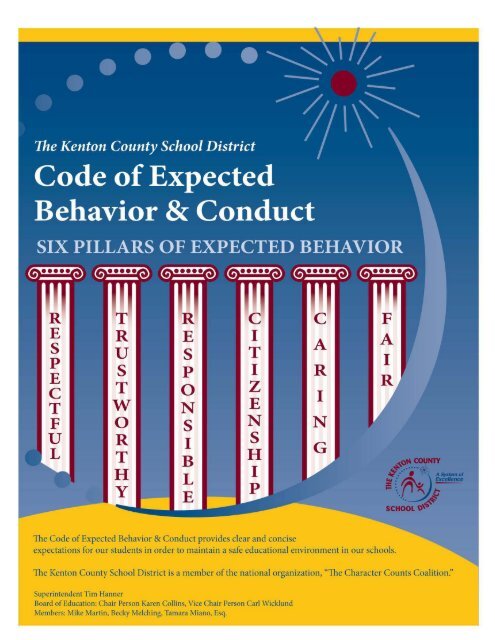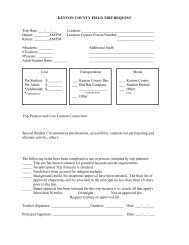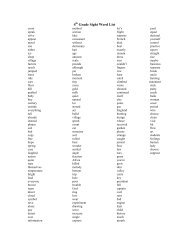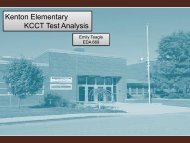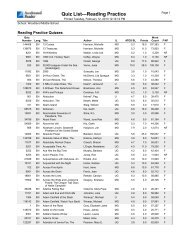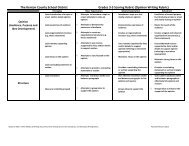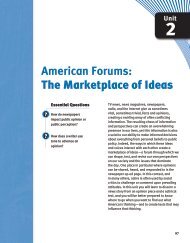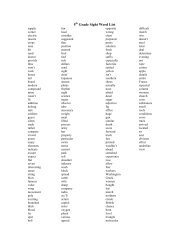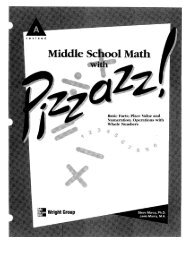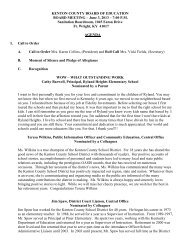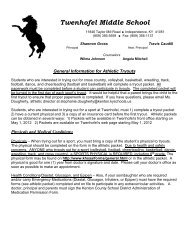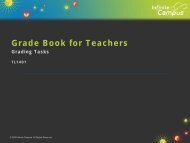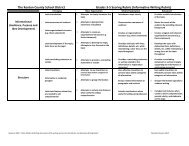Student Code of Conduct - Kenton County Schools
Student Code of Conduct - Kenton County Schools
Student Code of Conduct - Kenton County Schools
- No tags were found...
Create successful ePaper yourself
Turn your PDF publications into a flip-book with our unique Google optimized e-Paper software.
<strong>Code</strong> <strong>of</strong> Expected Behavior & <strong>Conduct</strong>PHILOSOPHY AND RATIONALEAll <strong>of</strong> our policies and procedures have been developed through the cooperative efforts <strong>of</strong> students, parents, teachers, andadministrative personnel <strong>of</strong> the <strong>Kenton</strong> <strong>County</strong> School District using a variety <strong>of</strong> sources designed to improve and maintain a positive andsafe learning environment. We ask that all students, staff and members <strong>of</strong> our learning community treat others as you would like to betreated. Using the “Six Pillars <strong>of</strong> Expected Behavior” as our examples, we strive to maintain a positive school attitude through theexpectations and rules for conduct for our students, staff and our learning community.This document has been developed for the following purposes:1. To provide certain disciplinary procedures to ensure that students may learn in an environment conducive to learning.2. To provide all concerned parties with information regarding regulations and procedures affecting the educational program as itpertains to individual rights and responsibilities.It is with these purposes in mind that this <strong>Code</strong> <strong>of</strong> Expected Behavior & <strong>Conduct</strong> has been developed. Pupils will be subject toschool discipline for any violation <strong>of</strong> this <strong>Code</strong> <strong>of</strong> Expected Behavior & <strong>Conduct</strong> at all school related functions including, but not limitedto, buses, traveling to and from school, regular school day activities, extracurricular and curricular activities at home, school facilities, oraway from school.This <strong>Code</strong> <strong>of</strong> Expected Behavior & <strong>Conduct</strong> provides for consistent and equitable treatment <strong>of</strong> all students in the <strong>Kenton</strong> <strong>County</strong>Public <strong>Schools</strong>. <strong>Student</strong>s will be responsible for adherence to this code in school, at school sponsored or related activities, on school buses,and at any extra-or co-curricular activities at, or away from school.This <strong>Code</strong> <strong>of</strong> Expected Behavior & <strong>Conduct</strong> provides for an annual review by the school community and the Board <strong>of</strong> Education toinsure an effective document, which meets the changing needs <strong>of</strong> the total educational community.This <strong>Code</strong> <strong>of</strong> Expected Behavior & <strong>Conduct</strong> provides the basic procedures which will be followed in disciplinary matters and themeanings and explanations <strong>of</strong> the procedures and the violations.The <strong>Kenton</strong> <strong>County</strong> School DistrictBeechgrove Elementary 371-1636J.A. Caywood Elementary 341-7062Ft. Wright Elementary 331-7742<strong>Kenton</strong> Elementary 356-3781Piner Elementary 356-2155R.C. Hinsdale Elementary 341-8226River Ridge Elementary 341-5260Ryland Heights Elementary 356-9270Summit View Elementary 363-4700Taylor Mill Elementary 356-2566White's Tower Elementary 356-9668Summit View Middle School 363-4800Turkey Foot Middle School 341-0216Twenh<strong>of</strong>el Middle School 356-5559Woodland Middle School 356-7300Dixie Heights High School 341-7650Scott High School 356-3146Simon <strong>Kenton</strong> High School 960-0100Success Academy 356-1502J.D. Patton Area Technology Center 341-2266Northern Ky. Youth Development Ctr 356-3172Transportation Department 356-5050TABLE OF CONTENTSSix Pillars <strong>of</strong> Expected Behavior….…….………………………………….…………………………. 02Six Pillars <strong>of</strong> Expected Bus Behavior and <strong>Conduct</strong> …………………………………….…….….…… 03Bullying Behaviors ………………………………………………………………………….………… 04Attendance Policies/Truancy.................................................................................................................. 05General Guidelines for Discipline Consequences…… .......................................................................... 06School Violations, Procedures, Due Process and Statutes..................................................................... 07Procedure Definitions............................................................................................................................. 08Violation Definitions.............................................................................................................................. 09Additional Information........................................................................................................................... 13The <strong>Kenton</strong> <strong>County</strong> School DistrictSPIRIT OF SPORTSMANSHIPThe <strong>Kenton</strong> <strong>County</strong> School District appreciates all <strong>of</strong> those who participate in and attend ourevents. Positive school spirit and sportsmanship are key factors to a successful event. Anybehavior or language, however, deemed inappropriate by the school administration and/orgame <strong>of</strong>ficials will not be tolerated and may be grounds for ejection from the game and/orfacility.2
STOP BULLYING BEHAVIORS!LIVE BY THE “SIX PILLARS OF EXPECTED BEHAVIOR”(KRS 158.154, 158.155, 158.156)Treat others as you would like to be treated - Respect, Responsibility, Trust, Fairness, Citizenship and CaringWhat is Bullying and/or Cyber-Bullying? Bullying and/or Cyber-Bullying is defined as any intentional, written, electronic (i.e.,Internet, Youtube, e-mail, text messages, picture phones); verbal or physical act or actions against another person that a reasonableperson knows will have the effect <strong>of</strong>:♦ Placing a person in reasonable fear <strong>of</strong> harm to his or her emotional or physical well-being or♦ Creating a hostile, threatening, humiliating or abusive educational environment due to the pervasiveness or persistence <strong>of</strong> actionsor due to a power imbalance between the bully and the target or♦ Interfering with a student having a safe school environment that is necessary for successful educational performance,opportunities or benefits or♦ Perpetuating bullying by inciting, soliciting or coercing an individual or group to demean, dehumanize, embarrass or causeemotional, psychological or physical harm to another person.Because we believe every student deserves a safe learning environment, the <strong>Kenton</strong> <strong>County</strong> School District is committed to dealingwith bullying behaviors in our schools. To help the student who is the target <strong>of</strong> bullying behaviors:1. We strive to identify the student who is using bullying behaviors, administer consequences for bullying behavior andhelp our students learn new ways <strong>of</strong> relating to others.2. We educate our school community <strong>of</strong> the serious impact <strong>of</strong> bullying behaviors in order to respond consistently to allinstances <strong>of</strong> bullying.What do bullying behaviors look like?• Inappropriate physical contact, including hitting, kicking,shoving, pushing• Intimidating and threatening comments either verbal,written or electronically• Name calling or put-downs• Malicious manipulation <strong>of</strong> others to do things they don’twant to do• Setting someone up to be bullied• Excluding from the group• Spreading rumors or hurtful gossip• Stalking• Hurtful teasing or making fun <strong>of</strong> someone• Harassment• Hiding or destroying someone’s belongings• Standing by and watching bullying behaviorBULLYING PREVENTION TIPSAre you being bullied? Do you bully others? Do you witness bullying?1. Tell a trusted adult what ishappening (like your parents,teacher, principal, bus driver orguidance counselor)1. Think about what you are doingand how it makes others feel.Think about their feelings, andthen don’t do it!1. Support someone who is beingbullied. Spend time and include himin activities or just talk to show youcare.2. Stay in a group so you won’t be aneasy target and so others can help.2. Hurting others and making themfeel bad is never cool. Think how2. Stand up to the person doing thebullying. Try to get other kids to join3. Try to stand up to the person who you feel when you’re hurt.you. It’s not easy, but it works.is bullying you. Tell him/her youdo not like it, what he/she is doingis wrong, and you want it stopped.3. Talk to an adult if you are not surewhy you bully others or how tostop, you need to talk about it. AWhen a bully sees that other kidsdon’t think bullying is cool, he’smore likely to stop.4. Make a joke. Sometimes humorcan make a bad situation moretrusted parent, teacher or counselorcan help you change.3. Report bullying to an adult. Kidswho are bullied may fear things willmanageable.4. Treat others as you would like to just get worse if they talk about it;5. Remember it’s not your fault; noone deserves bullying.be treated.kids who know they can’t get awaywith bullying may stop.Specific steps to reporting bullying behavior:If you or someone you know is being bullied or know <strong>of</strong> any unsafe conditions please report to any <strong>Kenton</strong> <strong>County</strong> Employee(teacher, counselor, advisor, principal, secretary) or 859-341-KIDS.If your child is involved in an incident related to KRS 158.156, the Principal shall notify parents/guardians in writing and createan incident report with police if required. Additionally, the Principal shall report only the number <strong>of</strong> students involved to the<strong>Kenton</strong> <strong>County</strong> School District Central Office, Department <strong>of</strong> <strong>Student</strong> Support Services.We believe much student misbehavior is a result <strong>of</strong> bullying.Therefore, in The <strong>Kenton</strong> <strong>County</strong> School District all bullying behavior is unacceptable!5
ATTENDANCE POLICIESAttendance calculations are as follows: Tardy Event will equal 35% or less <strong>of</strong> the school day. Half Day Event will equal 36% -83% <strong>of</strong> the school day. Whole Day Event will equal 84% or greater <strong>of</strong> the school day.COMPULSORYATTENDANCEATTENDANCEEVENTKENTONCOUNTYATTENDANCEPOLICYEXCUSEDATTENDANCEEVENTSUNEXCUSEDATTENDANCEEVENTSLATEARRIVALS TOSCHOOLTARDIESEARLYDISMISSALSMAKE-UPPOLICYNo Pass – NoDriveKRS 159.010 requires parents, guardians or custodians to send their child/children to school except as provided inKRS 159.030. Each parent, guardian, or other person residing in the state and having custody, guardianship, or incharge <strong>of</strong> any child who has entered the primary school program or any child between the ages <strong>of</strong> six (6) andeighteen (18) shall send their child to a regular public day school for the full term that the public school <strong>of</strong> the districtin which the child resides is in session, or to the public school that the Board <strong>of</strong> Education <strong>of</strong> the district makesprovision for the child to attend. 159.150 Definition <strong>of</strong> Truancy - Any child who has been absent from schoolwithout a valid excuse for (3) or more days, or tardy on (3) or more days is a truant regardless <strong>of</strong> the number <strong>of</strong>minutes tardy. Any child who has been reported as a truant (2) or more times is a Habitual Truant. KRS 159.150defines Habitually Truant students as those with six (6) or more unexcused absences.An Attendance Event includes any/all absences, tardies, late arrivals and/or early dismissals.An attendance policy has been developed in an attempt to comply with the state law, to emphasize the importance <strong>of</strong>attendance to a pupil’s education and the responsibility <strong>of</strong> the pupil and parent. Every effort has been made toprovide consistency, fairness and due process in its development. The <strong>Kenton</strong> <strong>County</strong> Attendance Policy allows fora limited number <strong>of</strong> excused attendance events, providing the responsible student and parent some flexibility, butalso providing consequences for unexcused attendance events. Excessive unexcused attendance events, includingabsences, tardies, late arrivals and/or early dismissals, may contribute to the loss <strong>of</strong> credits for the semester orretention for the school year. While all attendance events negatively affect student learning and performance,students with attendance events exceeding 10% <strong>of</strong> the school year do not meet school attendance policies, whichimpacts credits, promotion, retention and graduation. Disciplinary action for skipping school or truancy (#5 <strong>Code</strong> <strong>of</strong><strong>Conduct</strong>) may include a referral to Juvenile Court for Habitual Truancy or Educational Neglect.Excused attendance events include illness, physician visits, funeral/death <strong>of</strong> immediate family, and court appearancesmust meet established criteria. Parent notes are accepted for up to (3) events per grading period up to a maximum <strong>of</strong>nine (9) events per school year. Additional attendance events in a school year may be deemed unexcused without acertified doctor's statement indicating that the student was seen by the doctor and unable to attend school.Documentation including, but not limited to, physician statements (must state the date(s) the student was unable toattend school), court subpoenas, and other pro<strong>of</strong> may be required to excuse an attendance event in a case other thanpersonal illness. <strong>Student</strong>s and parents are responsible for all notes which are due upon return to school.Unexcused attendance events include skipping school, suspension, organized skip day, and attendance events notaccompanied by a note or attendance events not meeting excused guidelines. <strong>Student</strong>s with unexcused attendanceevents may not receive credit or make up work during time missed and are not permitted to attend school functionson unexcused absence days. Family vacations are considered avoidable and may be classified by the principal asunexcused.Late arrivals to school include any student who does not arrive to school on time. <strong>Schools</strong> have the discretion toassign consequences for students with unexcused late arrivals following the code <strong>of</strong> acceptable behavior guidelines.Chronic late arrivals will be treated as truant. According to 702 KAR 7:125, Section 7 (3), the State Law requiresthe legal parent/guardian sign in their elementary student.<strong>Student</strong>s who are not in their classroom before the tardy bell rings are considered tardy. <strong>Schools</strong> have the discretionto assign consequences for students with unexcused tardies following the code <strong>of</strong> acceptable behavior guidelines.Any student who leaves school before the end <strong>of</strong> the school day is considered to have an early dismissal. <strong>Schools</strong>have the discretion to assign consequences for students with unexcused early dismissals following the code <strong>of</strong>acceptable behavior guidelines. Chronic early dismissals may be treated as truancy. Depending on the time <strong>of</strong> theearly dismissal, this attendance event may be coded as a tardy in the school’s computer system.Makeup work is the sole responsibility <strong>of</strong> the student missing school. <strong>Student</strong>s with excused attendance eventsshould see their teachers the day they return to begin the make-up process. For excused attendance events, it isrecommended that school’s SBDM polices for make-up work be applied or students should be given one day foreach absence in order to complete makeup work. Work not made up in time will be graded according to the school'spolicy for late work.No Pass/No Drive Law (KRS 159.051) pairs the responsibility <strong>of</strong> maintaining good grades and attendance in theclassroom with the privilege <strong>of</strong> driving. The No Pass/No Drive law states that a student will be denied his or herdriver’s learning permit/license or have his or her license revoked for 1) academic deficiency, 2) dropping out <strong>of</strong>school as a result <strong>of</strong> unexcused absences or 3) traditional drop out. A student shall be considered academicallydeficient when he or she has not received passing grades in at least four courses, or the equivalent <strong>of</strong> four courses(66%). If a sixteen or seventeen year-old student (with a driver's permit or license) accumulates nine or moreunexcused absences, does not meet the academic requirements, or if they drop out <strong>of</strong> school, attendancerequirements, the school will report the student as noncompliant. Any absences due to suspension shall bedeemed as unexcused absences. At minimum, the student needs to be in compliance for an entiresemester/trimester prior to reinstatement.6
GENERAL GUIDELINES FOR TEACHER LEVEL DISCIPLINE CONSEQUENCESJust like all classroom learning, the purpose behind general guidelines for discipline consequences is to teach and instructdiscipline. When used correctly discipline should be administered in a positive and proactive way in order to improve thelearning environment for all students.General Guidelines for Discipline Consequences: When imposing discipline, district personnel shall adhere to the followinggeneral guidelines:1. Discipline shall be administered when necessary to protect students, school employees or property, and to maintainessential order in the learning environment.2. <strong>Student</strong>s shall be treated fairly and equitably. Consequences will be administered after a careful assessment <strong>of</strong> thecircumstances <strong>of</strong> each case. Factors to consider shall include:• Threat to the safety <strong>of</strong> all• Seriousness <strong>of</strong> the <strong>of</strong>fense• <strong>Student</strong>’s age• Frequency <strong>of</strong> misconduct• <strong>Student</strong>’s attitude• Potential effect <strong>of</strong> the misconduct on the school environment.3. All types <strong>of</strong> disciplinary infractions may not be included within this document. For these teacher-level items and forany items not included, the principal may use his/her own discretion on the consequences.Teacher level incidents:• Tardiness to class• Failure to bring appropriate materials to theclassroom• Refusal to participate in classroom activities• Talking in class• Sleeping in class• Cheating/dishonesty• Eating, drinking or chewing gum in the classroomPossible teacher level consequences:• <strong>Student</strong> conference• <strong>Student</strong>-teacher contract• Special assignment or duties• Parent contact• A grade <strong>of</strong> zero for cheating• Rewards or demerit system for behavior• Verbal correction• Cooling-<strong>of</strong>f or time-out• Special seating assignment in classroom• Reteaching Expected Behavior• Teacher level probationary agreement• Teacher assigned detention• Radios, CD players, cameras, games in class or atfunctions, MP3 players or similar devices.• Inappropriate cafeteria conduct• Inappropriate hall conduct• Poor sportsmanship in classroom activities• Throwing objects (spitballs, paper, airplanes, etc.)• Public display <strong>of</strong> affection• Parent-teacher conferences• Temporary confiscation <strong>of</strong> items that disrupt theeducational process• Withdrawal <strong>of</strong> classroom privileges• Conferencing with teachers, special services, oradministrative personnel• Referral to School Guidance Counselors• Sending the student to the <strong>of</strong>fice or other assignedareas• Providing outside agency information for parentpersonal useREPETITION AND SEVERITY IN THIS CATEGORY MAY RESULT IN MORE SERIOUS DISCIPLINE INCLUDINGSUSPENSION THROUGH THE PRINCIPAL'S OFFICE.7
The <strong>Kenton</strong> <strong>County</strong> School District Violations & ProceduresDisciplinary Actions are utilized by The <strong>Kenton</strong> <strong>County</strong> School District to maintain the educational environment and protect each student's right to afree and appropriate education. This code <strong>of</strong> conduct covers all <strong>of</strong> The <strong>Kenton</strong> <strong>County</strong> School District events including those on school grounds, buses, andactivities sponsored by the school. Definitions <strong>of</strong> the violations and procedures are contained in the pages following this chart.Elementary and middle school principals have the discretion to administer consequences at a lower step in consultation with the <strong>Kenton</strong> <strong>County</strong> SchoolSuperintendent or designee. Where there are two sets <strong>of</strong> procedures, the first set refers to elementary/middle; the second set is for high school.Offenses requiring Administrative Action and/or MAY require Suspension and/or Expulsion depending on situation.Violations Procedure Board <strong>Code</strong>Attendance Late Arrivals to School A-C, 1003Attendance Tardies to Class A-C, 1006Attendance Skipping School/Leaving School Grounds A-C, 1003, 1004Attendance Truancy A-C, 1007Bullying A-D, D-G+* 8001Bus Disturbance A-F 2002Cheating/Plagiarism/Dishonesty A-C 1001Communication Device/Cell Phone A-D 1010, 8005Defiance <strong>of</strong> Authority A-D 1010Destructive Disorderly <strong>Conduct</strong> A-F 2001, 2002Disruptive Disorderly <strong>Conduct</strong> A-D 2001, 2002Dress <strong>Code</strong> A-C 1002Failure to Complete Assignments A-C 1010Failure to Comply with Disciplinary Actions A-D 1010Falsifying Notes/Forgery/ Counterfeiting A-D 1008Harassment A-D, D-G+* 8002Inappropriate Materials A-C 1010Marketing/Buying and/or Selling Items A-C 1010Pr<strong>of</strong>anity/Vulgarity A-C 70Public Display <strong>of</strong> Affection (PDA) A-C 60Repeated Violations B-G 1010Smoking/Chewing/Smoking Paraphernalia/Tobacco B-D* 9001, 9002, 9003Verbal Abuse C-E 8004Willful Misconduct (Fighting) B-F 5001-5003Offenses MAY require Suspension and/or ExpulsionVIOLATION2 nd OffenseProcedure Middle/High Board <strong>Code</strong> State <strong>Code</strong>Aggressive to School Employee A-F, D-G+* G+* 8003, 8004 240, 340, 341All Other Offenses A-G+* A-G+*Arson ** G+* G+* N/A 90Assault – (Degree 1 st , 2 nd , 3 rd ,4 th ) ** D-G+* E-G+* N/A 301, 302, 303, 304Beyond Control <strong>of</strong> School H H 2001, 2002 240Burglary/Larceny/Theft/Robbery/Stolen Property ** B-D, C-F* C-G+* 1009 50, 60, 130Disorderly <strong>Conduct</strong> ** A-D C-F+* N/A 240Drug/Alcohol Distribution/Possession F-G+*(M) F-G+*(M) N/A 1801 - 1892Fraud ** A-C A-C N/A 110Gangs, Gang Related/Gang Like Activity A-D, E-G+* D-G+* 2001 260, 240, 308, 309Libel/Slander Toward Any Employee ** A-F, D-G+* G+* N/A 240Menacing/Improper Driving ** E-G+* G+* N/A 305Sexual Misconduct ** G+* G+* 60 20, 160, 172, 174Terroristic Threatening ** D-G+* E-G+* 8001, 8002, 8003 310, 320, 330Under the Influence F-G+*(M) F-G+*(M) N/A 1801 - 1892Vandalism (Criminal Mischief) B-F B-G+* N/A 140Violating Security Procedures C-F C-F 2001 310, 320, 330Violation <strong>of</strong> AUP/Inappropriate Computer Use C-F C-F 2001 310, 320, 330Weapon (Firearm Only) ** F-G* G* N/A 151 - 153Weapon Other/Dangerous Instrument C-G* G* 110 154School personnel will follow appropriate due process procedures unless immediate suspension is essential for safety reasons or to avoid disruption <strong>of</strong> the educational environment.**To level <strong>of</strong> law violation.STEPS TO DISCIPLINARY PROCEDURES1. Confer/Investigate with parties concerned as soon as possible, 2) Assign consequence defined by the <strong>Code</strong> <strong>of</strong> Acceptable Behaviors and Discipline, 3) Notify legal guardian byphone, letter, or message as soon as possible.PROCEDURESA - Warning/Probation/Contract/<strong>Student</strong> ConferenceB - Alternative Assignment/Detention/Zero for cheatingC - Friday/Saturday School/Suspend bus 1-5 days.D - ICE+/Suspend-school 1-5 days/Suspend-Bus 6-10 days.E - ICE+/Suspend-school 6-10 Days/Suspend-Bus Minimum 10 days up torecommendation for the rest <strong>of</strong> the school year.F - Out <strong>of</strong> School SUS 1-10 Days pending Dist. Admin. Hearing.G - Recommendation for Expulsion.H - Court Appearance for status <strong>of</strong>fense.+ = Isolated Curriculum Environment,(M) = 8 week Counseling Program (no extracurricular activities during that time), Drug Screening(at parents/ legal guardian’s cost), Behavior Contract, and School Level or District AdministrativeHearing.* = Notify proper law enforcement <strong>of</strong>ficials as necessary (KRS 158). All felonies must be reported toprincipal following school board procedures and reported to the Central Office Designee and properlaw enforcement.8
PROCEDURE DEFINITIONSSTUDENT CONFERENCEWARNING/PROBATION/CONTRACTDETENTIONALTERNATIVE ASSIGNMENTFRIDAY/SATURDAY SCHOOLISOLATED CURRICULUMENVIRONMENT (ICE)BUS SUSPENSIONSUSPENSIONDISTRICT ADMINISTRATIVEHEARINGEXPULSIONREPORT TO AUTHORITIESConference (informal or formal) held between the student and a member <strong>of</strong> theschool administrative team.A contract between the student, parents, and the school to reinforce good behavior.Detaining a student after school, before school, or during the student's free time (e.g.lunch) with advance notice to the parent and/or student as appropriate.Short term placement in separate supervised and structured school program thatallows students to complete assignments, take tests, and be counted as present inschool. This placement may impact a student's participation grades in a course orcourses. During AA, students will be socially isolated from the regular environment.Extended length detention after school on Friday or on a Saturday (may be used as analternative to suspension at the principal's discretion).<strong>Student</strong>s are removed from their regular classes to an isolated environment. <strong>Student</strong>swill be in a restricted classroom with very restricted guidelines. <strong>Student</strong>s will not beable to socialize with the student body and will eat lunch in a restricted classroom.Restroom breaks will be limited and closely supervised. <strong>Student</strong>s in ICE will beallowed and expected to complete school work to be included as part <strong>of</strong> final grade.Not permitting a student to ride the school bus to or from school for full or partial day(s) following appropriate due process procedures. While suspended, it will be thelegal parent/guardians responsibility to transport their child to/from school.Transportation is a privilege, not a right.Not permitting a student to attend school for full or partial day(s) followingappropriate due process procedures. While suspended, students do not receive creditfor daily assignments, but are allowed to make up major tests, quizzes and projects.While suspended, students are not permitted to attend school-sponsored events.For any extremely serious <strong>of</strong>fense that may warrant more than a 10 day suspension, aDistrict Administrative Hearing will be held. Outcomes <strong>of</strong> this hearing could includeany/all disciplinary action outlined in the “<strong>Code</strong> <strong>of</strong> Acceptable Behavior andDiscipline and/or agreed upon by school and student/guardian.Removal <strong>of</strong> student's right to attend school for a period <strong>of</strong> time over 10 days not toexceed one calendar year. Following guidelines <strong>of</strong> the code <strong>of</strong> conduct, the principalmay recommend expulsion in writing to the superintendent. The Board <strong>of</strong> Educationhas the authority to expel a student. Also, see school reassignment below.Any <strong>Kenton</strong> <strong>County</strong> employee who knows or has reasonable cause to believe that aschool student has been the victim <strong>of</strong> a violation <strong>of</strong> any felony <strong>of</strong>fense as specified inKRS Chapter 508 (assault, wanton endangerment, stalking, menacing, terroristicthreatening) committed by another student while on school premises, on schoolsponsored transportation, or at a school sponsored event must immediately make areport to the principal <strong>of</strong> the school the student attends. The principal will contact thestudent’s legal parent/guardian and make a report to the local school board and locallaw enforcement agency. A report may coincide with any <strong>of</strong> the steps above.ADDITIONAL PROCEDURE INFORMATION AND DEFINITIONSSCHOOL REASSIGNMENTDIVERSION TO EXPULSIONPROGRAMThe superintendent or his/her designee has the right to reassign a student to adifferent placement within his/her school or to another school within the districtfollowing a recommendation for expulsion from the school. This placement may befor up to one calendar year.A program operated by the school as an alternative to school expulsion.9
VIOLATIONS/DEFINITIONSAGGRESSIVE MISBEHAVIOR TOWARDSCHOOL EMPLOYEESVerbal abuse, threats, physical contact, or threat <strong>of</strong> physical contact by student(s) towardschool employee(s). <strong>Student</strong> conduct toward staff may be grounds for legal charges for Abuse<strong>of</strong> Teacher and/or other statutes.*Example(s): Pr<strong>of</strong>anity towards staff member hitting, kicking, or shoving a staff member.ALL OTHER OFFENSESAnything not specifically detailed but constituting cause for discipline measures includingsuspension or expulsion. This may include, but is not limited to blackmail and extortion;criminal anarchism; criminal syndicalism; and kidnapping.ARSON (or attempted arson)Starting a fire within the school, on buses, or on the school grounds, for any purpose that(To Level <strong>of</strong> Law Violation)results in destruction or disruption.ASSAULT (To Level <strong>of</strong> Law Violation) Intentionally causing harm to other(s). According to Kentucky Revised Statues 508.010,508.020, 508.030, and 508.040, assault is classified in four different ways: Assault in the firstdegree, second degree, third degree, and fourth degree. The level <strong>of</strong> the assault will dependupon the nature <strong>of</strong> the injury sustained and if a deadly weapon or dangerous instrument wasused. It should be noted that these are not legal definitions. Due to the ramifications <strong>of</strong>coding errors for assault <strong>of</strong>fenses, please consult <strong>Student</strong> Support Services who will worklocal law enforcement or the school board attorney regarding how to code assaultincidents.ATTENDANCE/LATE ARRIVALS TOSCHOOLATTENDANCE TARDIES TO CLASSATTENDANCE SKIPPINGSCHOOL/LEAVING SCHOOL/GROUNDSATTENDANCE TRUANCYBEYOND CONTROLBULLYING/HAZINGBURGLARY/LARCENY/THEFT/ROBBERY/STOLENPROPERTY(To Level <strong>of</strong> Law Violation)BUS DISTURBANCE (Includes behavior onbus or conduct at bus stop)*Example(s): Fighting or attacking another person with a weapon to cause serious physicalharm that could cause serious physical injury or risk <strong>of</strong> death. Fighting or attacking anotherperson with or without a weapon to cause physical injury.A student who does not arrive to school on time.A student who does not get to class before the tardy bell rings.Skipping school, class, or leaving school or school grounds without permission.Any child who has been absent from school without a valid excuse for (3) or more days, ortardy on (3) or more days is a truant regardless <strong>of</strong> the number <strong>of</strong> minutes tardy. Any child whohas (6) or more unexcused attendance events is a Habitual Truant. Habitual Truancy is a status<strong>of</strong>fense and may result in a mandatory court appearance by the student and parent.Demonstrating chronic non-compliant behavior (nine or more documented discipline referralsin a school year, three or more separate incidents <strong>of</strong> out <strong>of</strong> school suspension in a school yearor one single issue that is <strong>of</strong> a very serious nature). These actions may result in a mandatorycourt appearance by the student and parent.When someone and/or a group uses POWER or INTIMIDATION to hurt or scareanother person. Including but not limited to means <strong>of</strong> intentional written, electronic,verbal or physical act or actions against another person(s). Any act which endangers themental or physical health or safety <strong>of</strong> a person, embarrasses, frightens, or degrades a person orwhich destroys or removes public/private property, for the purpose <strong>of</strong> initiation, admission into,or affiliation with, or as a condition for continued membership, in a group, organization/team.The expressed or implied consent <strong>of</strong> the alleged person against whom the actions have beentaken will not be a defense. Apathy or acquiescence in the presence <strong>of</strong> hazing is not neutralacts; they are violations <strong>of</strong> this rule. <strong>Student</strong>s being bullied or who know <strong>of</strong> someone beingbullied must report this to a school <strong>of</strong>ficial.A person is guilty <strong>of</strong> burglary when, with the intent to commit a crime, he knowingly enters orremains unlawfully in a building. A building, in addition to its ordinary meaning, means anystructure, school, school grounds, bus, or other vehicle where any person lives or where peopleassemble for purposes <strong>of</strong> business, government, education, religion, entertainment or publictransportation. Thus, breaking into a bus and stealing something from the bus would becounted as burglary. The taking or attempting to take anything <strong>of</strong> value from the care, custody,or control <strong>of</strong> a person or persons by force or threat <strong>of</strong> force and/or putting the victim in fear.The intentional taking <strong>of</strong> the property <strong>of</strong> another in additional to buying, receiving, possessing<strong>of</strong> stolen property.<strong>Conduct</strong> on the bus which makes for an unsafe condition for students, driver and othermotorists or others.CHEATING/PLAGIARISM/DISHONESTYDoing something unfair or dishonest in order to gain something for oneself or another.Stealing the work <strong>of</strong> another in order to use it as one's own work. Intentionallymisrepresenting the truth.*Example(s): Turning in another student’s paper as your own, paying someone to do yourschoolwork for you, giving your work to others to use or copy, looking at another student’swork in class, and then copying similar items.*Examples may include but are not limited to the list included.10
COMMUNICATION DEVICES/CELLPHONESPersonal Telecommunications Device means a device that emits an audible signal, vibrates,displays a message, or otherwise summons or delivers a communication to the possessor,including, but not limited to, a paging device and a cellular telephone. <strong>Student</strong>s and staff have aright to an expectation <strong>of</strong> privacy while on school grounds. Due to this, unauthorized taping,duplication, picture taking, audio, video, or other means or methods are strictly prohibited.By choosing to allow your student to bring any type <strong>of</strong> COMMUNICATION DEVICES/CELLPHONES to school, parents/legal guardians agree and support the following:• <strong>Schools</strong> may require students to register cell phones and numbers in order to carrythem on campus.• The restrictions below shall not be interpreted to prohibit material protected underthe state or federal constitutions where such material does not otherwise materially orsubstantially disrupt the education process or intrude upon the rights <strong>of</strong> others.• When students violate prohibitions <strong>of</strong> this policy, they shall be subject to disciplinaryaction, including losing the privilege <strong>of</strong> bringing the device onto school property andbeing reported to their parent/guardian. A violation also may result in a report beingmade to law enforcement.• The contents <strong>of</strong> cell phones can be searched by school administration. In addition, anadministrator may confiscate the device, which shall only be returned to the student’sparent/guardian. CONFISCATION MAY INCLUDE THE CELL PHONE ANDSIM CARD.• KRS 158.165 (The school district accepts no responsibility for use, breakage, theft orloss <strong>of</strong> these personal items). Also refer to the AUP (Acceptable Use Policy)VIOLATIONS. Consequences may include removing computer privileges as well asadditional consequences A-F <strong>of</strong> The <strong>Kenton</strong> <strong>County</strong> School District Violations andProcedures.• Devices shall not be used in a manner that disrupts the educational process, includingbut not limited to:‣ Poses a threat to academic integrity, such as cheating‣ Violates confidentiality or privacy rights <strong>of</strong> another individual‣ Is pr<strong>of</strong>ane, indecent, or obscene‣ Constitutes or promotes sending, sharing or possessing sexually explicitmessages photographs, or images using any electronic device.The use <strong>of</strong> cell phones and other electronic media usage may be directed by teachers throughclassroom assignments. <strong>Schools</strong> may require phones to be turned <strong>of</strong>f as appropriate.Additional policies on phone or other electronic media use may be added or enhanced by theSchool SBDM. At no time, should a phone or other electronic media device interruptclassroom instruction. <strong>Student</strong>s with phones that ring or vibrate interrupting instruction mayface consequences for this disruptive conduct.DEFIANCE OF AUTHORITYDESTRUCTIVE DISORDERLYCONDUCTDISORDERLY CONDUCT(To Level <strong>of</strong> Law Violation)*Example(s): <strong>Student</strong>s taking pictures <strong>of</strong> other students on their phones, modifying it andsending it to others. <strong>Student</strong>s taking pictures/texting about other students and spreading rumorsabout the student in the messages. <strong>Student</strong>s taking pictures <strong>of</strong> themselves or others, sending itaround, for personal gain.Refusal to comply with reasonable request <strong>of</strong> school personnel.*Example(s): Anything that could be rational and law abiding students are asked to do andthey refuse.Dangerous or destructive conduct while also being disorderly at school or on buses including,but not limited to, throwing harmful objects, scuffling or lack <strong>of</strong> control <strong>of</strong> voice, language orlimbs. This type <strong>of</strong> conduct does create a danger to self or others.*Example(s): Anything dangerous to self and/or others, whether it causes damage or not.Committing a breach <strong>of</strong> the peace. In Kentucky, a person is guilty <strong>of</strong> disorderly conduct whenin a public place and with intent to cause public inconvenience, annoyance or alarm, or creatinga risk there<strong>of</strong>. It should be noted that these are not legal definitions. Due to theramifications <strong>of</strong> coding errors for disorderly conduct, please consult <strong>Student</strong> SupportServices who will work local law enforcement or the school board attorney regarding howto code disorderly conduct incidents.*Example(s): Making unreasonable noise such as yelling out in class, hallways, cafeteria etc.Refusing to obey a staff member during an emergency situation such as a fire or fire drill etc.Fighting and refusing to stop. Dramatic behavior that serves no legitimate purpose.*Examples may include but are not limited to the list included.11
DISRUPTIVE DISORDERLY CONDUCTDRESSDRUGS/ALCOHOL (Prescription/ DietarySupplements/Herbals, Others, Anyalcohol/alcoholic items)(To Level <strong>of</strong> Law Violation)FAILURE TO COMPLETEASSIGNMENTSFALSIFYING/FORGERY/COUNTERFEITINGFRAUD(To Level <strong>of</strong> Law Violation)GANGS, GANG-RELATED AND GANG-LIKE ACTIVITIESHARASSMENT(To Level <strong>of</strong> Law Violation)INAPPROPRIATE COMPUTERUSE/VIOLATION OF AUPINAPPROPRIATE MATERIALSLIBEL/SLANDER TOWARD ANYEMPLOYEE(To Level <strong>of</strong> Law Violation)MARKETING OR BUYING AND/ORSELLING OF ITEMSMENACING/IMPROPER DRIVING(To Level <strong>of</strong> Law Violation)Disrupting the orderly educational environment at school or on buses including, but not limitedto, throwing objects, horseplay, public display <strong>of</strong> affection, any unauthorized editing or use <strong>of</strong>media and/or audio that disrupts the educational environment/atmosphere is prohibited. Thisincludes posting video and/or audio to internet that is disruptive to the learning environment.*Example(s): Screaming out in class, common student spaces (hallways, bathrooms,commons, lunchroom, gym), causing a scene with dramatic behaviors or noise. Touching,hugging, kissing, texting, sending photos with questionable items in them, slapping each otheras play, pulling desks out from under students and inappropriate comments are all examples.DRESS-Work-place environments have expectations for dress. School SBDM Councils mayenhance expectations for student dress. The dress code ensures appropriate clothing that is not<strong>of</strong>fensive, provocative or disruptive and that reinforces safe behaviors and a safe and orderlylearning environment. For safety reasons shoes must be worn at all times. We stronglyencourage that shoes be secure through fit or strapping.Use, Possession or Under the Influence; Sale, Transfer or Distribution <strong>of</strong> a drug, look-alikedrug, prescription medication, over-the-counter medicine, or drug paraphernalia including(pipes, roach clips, hemostats, rolling papers, etc.) Drugs are defined as prescription (must betaken in accordance with school policy requiring a written pre-approved medical formcompleted by a physician) or any substance that has a harmful or unnatural effect on the personusing them. This includes possession, use or under the influence on school property or at aschool sponsored function. Possession includes items found on school property or at a schoolsponsored function. (To include, but not limited to locker assigned to student, vehicles drivenby the students, any other place deposited by student including purse, backpack, garbagecontainer, etc.)Includes failure to complete assignments and or bring materials for class. It is expected that,prior to any referral <strong>of</strong> this nature, the teacher must provide documentation <strong>of</strong> parent contactand teacher interventions.Occurs when a person, with intent to defraud, deceive or injure another, falsely makes,completes or alters a written instrument (e.g., checks, transcripts, <strong>of</strong>ficial identification,currency).*Example(s): Forged notes <strong>of</strong> any kind including absent notes, forged signature on permissionslips or items being returned to school for any reason, false notes from doctors or others.A deception deliberately practiced in order to secure unfair or unlawful gain. 2. A piece <strong>of</strong>trickery; a trick.The presence <strong>of</strong>, or student involvement in, gangs, gang-related, or gang-like activities onschool property or at school-related events. Gang related items include but are not limited tothe display <strong>of</strong> gang symbols, drawings, paraphernalia or apparel (bandanas, hats/caps, or anyitem that may interfere with the process <strong>of</strong> maintaining a safe school environment)Operates with intent to intimidate, harass, annoy, or alarm another person.*Example(s): Making prank phone calls, text messaging, verbal abuse, spreading rumors,writing notes etc. to hurt, intimidate, humiliate or embarrass another person or people.Modifying the network or computer hardware and/or s<strong>of</strong>tware to accomplish a goal outside <strong>of</strong>the district’s original intent. <strong>Student</strong>s have a right to an expectation <strong>of</strong> privacy while on schoolgrounds. Due to this, unauthorized taping, duplication, audio, video, or other means ormethods are strictly prohibited.Possession, handling, transmitting, or using inappropriate materials including, but not limitedto, those that degrade, attack or endorse an ethnic background, religion and race, health, safety,sexually explicit, pornographic, and libelous items.Any statement or portrayal (written/verbal/posted, etc.) on the Internet or any othercommunication that falsely disparages anyone’s pr<strong>of</strong>essional competence and/orreputation. NOTE: In addition to school level consequences, our employee(s) and/or theDistrict have the right to file criminal charges and/or civil litigation.Marketing, buying and/or selling <strong>of</strong> items not previously approved by the building principal.Intentionally placing self or other person(s) in harm’s way or endangering the safety, healthand/or welfare <strong>of</strong> self or others on school property or at school sponsored events, including butnot limited to recklessly operating a motor vehicle.PROFANITY/VULGARITYPUBLIC DISPLAY OF AFFECTION (PDA)*Examples may include but are not limited to the list included.*Example(s): Threatening to beat another student up, threatening to harm another person out<strong>of</strong> anger without following through with the threat, speeding or unsafe wreckless driving inschool parking lot, acting as if you are going to run over another person.Spoken or written words that are recognized as swear or curse words. Some words whilepr<strong>of</strong>ane or vulgar may be deemed for grounds <strong>of</strong> other classification according to the code <strong>of</strong>conduct. The Principal makes the final decision to what constitutes word(s) as pr<strong>of</strong>anity/vulgaror other violation.Inappropriate embracing, touching, kissing and/or activities that others see or witness toinclude viewing through security cameras.12
REPEATED VIOLATIONSSEXUAL MISCONDUCT(To Level <strong>of</strong> Law Violation)SMOKING/CHEWING/SMOKINGPARAPHERNALIA/TOBACCO OTHERSTOLEN PROPERTY (RECEIVING)TERRORISTIC THREATENING – BOMBTHREAT (To Level <strong>of</strong> Law Violation)UNDER THE INFLUENCE(To Level <strong>of</strong> Law Violation)VANDALISM (Criminal Mischief) (ToLevel <strong>of</strong> Law Violation)VERBAL ABUSEVIOLATING SECURITYDemonstrating a documented pattern <strong>of</strong> inappropriate behavior for which the availableprocedures are not sufficient or a minimum <strong>of</strong> three (3) referrals in one school year for thesame violation.Subjecting another person(s) to sexual contact by forcible compulsion; or Participant(s)subjecting another person to sexual contact who is incapable <strong>of</strong> consent because he/she: isphysically helpless; less than sixteen (16) years old; or is mentally incapacitated includingwilling participant(s). This includes any type <strong>of</strong> Sexual Activity, Misconduct or Exposure atschool, on the school bus or at any school sponsored event for any age student including(sexting) the act <strong>of</strong> sending sexually explicit messages or photos, videos, audio or visual fileselectronically, primarily between cell phones or other electronic media.Use, possession, sale or transfer <strong>of</strong> tobacco products or possession <strong>of</strong> smoking paraphernalia(lighters, matches, tobacco packs, etc.) Violation <strong>of</strong> this section (KRS 438.311) may also resultin a fine and/or community service work assigned by the court.Include buying, receiving, possessing <strong>of</strong> stolen property.He/she threatens to commit any crime likely to result in death or serious physical injury toanother person or likely to result in substantial property damage to another person; orintentionally makes false statements for the purpose <strong>of</strong> causing evacuation <strong>of</strong> a building, place<strong>of</strong> assembly, or facility <strong>of</strong> public transportation.*Example(s): Pulling fire alarms, threatening to kill another person. Calling school to say thereis a bomb in the building.Includes all <strong>of</strong>fenses <strong>of</strong> intoxication with the exception <strong>of</strong> driving under the influence. InKentucky, this <strong>of</strong>fense equates to alcohol intoxication and/or public intoxication, which occurswhen a person appears in a public place manifestly under the influence <strong>of</strong> alcohol, a controlledsubstance, or other intoxicating substance.The intentional destruction, injury, disfigurement, or defacement <strong>of</strong> any public or privateproperty without consent <strong>of</strong> the owner or person having custody or control (i.e., by cutting,tearing, breaking, marking, painting, drawing, or covering with filth). Loss <strong>of</strong> $500.00 or morerequires a police report.To insult by means <strong>of</strong> words.Compromising district and/or school security procedures or putting others at risk. Making athreat or falsely alerting that a bomb has been placed or is about to explode.WEAPON (FIREARM ONLY)(To Level <strong>of</strong> Law Violation)WEAPON OTHER/DANGEROUSINSTRUMENTWILLFUL MISCONDUCT (Fighting)*Examples may include but are not limited to the list included.*Example(s): Trespassing, failure to follow lock down, opening <strong>of</strong> exterior doors other thansingle monitored entrance, tampering <strong>of</strong> security cameras, telephone and/or fire alarm system,remaining on school grounds after posted hours without prior permission from school <strong>of</strong>ficials,use <strong>of</strong> fireworks, noxious substances, and intentionally reporting false tips to administrators,teachers, other sources, etc.Use, Possession, Sale, Transfer or Distribution - A firearm is any weapon that will expel aprojectile by the action <strong>of</strong> an explosive. This <strong>of</strong>fense encompasses manufacture, sale, orpossession <strong>of</strong> firearms on school property or at a school function. (KRS 527.070).Use, Possession, Sale, Transfer or Distribution - <strong>of</strong> any object determined by the principal to bedangerous and capable <strong>of</strong> being readily used by one person to inflict severe bodily injury uponanother person; examples include but not are limited to air guns, knives, artificial knuckles,club, baton, nunchaku karate sticks. (KRS 527.070)Willingly engaging in physical contact for the purpose <strong>of</strong> inflicting harm on the other person.Any provocation (verbal/physical) may be considered a mitigation <strong>of</strong> the charge. A studentwho finds himself/herself the victim <strong>of</strong> an attack should make every effort to get out <strong>of</strong> thesituation including blocking, running, and calling for help13
ADDITIONAL INFORMATION FOR STUDENTS AND GUARDIANSRights and Responsibilities • <strong>Student</strong>s have many rights, which include access to a system <strong>of</strong> public education thatmeets the needs <strong>of</strong> the individual student in an educational environment that is safe andstable.• <strong>Student</strong> responsibilities include being accountable for their own conduct and forconsideration for the rights and property <strong>of</strong> others. Parent’s rights include sending theirchild to a school with a safe, stable environment where learning is valued. Parents have anumber <strong>of</strong> responsibilities that include instilling in their children the value <strong>of</strong> aneducation, a sense <strong>of</strong> responsibility and respect.• Teachers have the right to a stable, safe work environment where they can teach skills andconcepts while caring for the overall developmental needs <strong>of</strong> the whole child. Teacher'sresponsibilities include presenting subject matter and experiences to students and toinform parents and students <strong>of</strong> positive academic achievements as well as problematicperformance or behaviors.• Administrators and other staff are critical parts <strong>of</strong> the school community. Rights andresponsibilities for Principals and bus drivers have also been developed.• The previous passage is an abridged overview <strong>of</strong> the full series <strong>of</strong> "Rights andResponsibilities." The full version can be found in the <strong>Kenton</strong> <strong>County</strong> Board <strong>of</strong>Education "Policies and Procedures" Manual.Due ProcessIn all discipline cases, school personnel will follow appropriate due process procedures.Ordinarily, a student shall not be suspended before being given oral or written notice <strong>of</strong>charges constituting suspension, an explanation <strong>of</strong> the evidence, and an opportunity to presenttheir version <strong>of</strong> the facts. Whenever a suspension is being given as a consequence, the schoolwill make every effort to contact parents and to share the specifics related to the case.Immediate suspension will only be used if it is essential for safety reasons or to avoiddisruption <strong>of</strong> the educational environment. In these cases, due process guidelines should occurFamily Education Rights andPrivacy Act (School Records)Grievance ProceduresLaw Violationsby phone or by written statement within three school days following the suspension.• In accordance with the Family Education Rights and Privacy Act, parents may review alleducation records relating to their child. This right is extended to students at age eighteen.<strong>Student</strong>s have a right to an expectation <strong>of</strong> privacy while on school grounds. Due to this,unauthorized taping, duplication, audio, video, or other means or methods are strictlyprohibited. Parents also have the right to file complaints if the district does not complywith this act. Parents <strong>of</strong> graduated students enrolled in a program for exceptionalchildren, or <strong>of</strong> students who have otherwise left school, may request the destruction <strong>of</strong> anypersonally identifiable information, which was used for the identification, evaluation, orplacement <strong>of</strong> the exceptional child. Such requests must be in writing to the SpecialEducation Director.• In accordance with federal regulations concerning the transfer <strong>of</strong> educational records, thisdistrict will forward records on request to a school in which students seek to enroll. Uponwritten request, parents can obtain copies <strong>of</strong> these records and discuss these records ifnecessary.• Parents may request information from the school regarding the pr<strong>of</strong>essional qualifications<strong>of</strong> their child’s classroom teacher.Note: All student records are confidential and can only be released through properauthorization.Parents questioning actions taken by the school may do the following:F. In classroom matters, contact the teacher to discuss the problem.G. If the teacher meeting does not resolve the problem, the teacher and parents can arrange ameeting with the principal.H. If the problem is not classroom related, the parents may contact the principal.I. If none <strong>of</strong> the above procedures are satisfactory, parents may appeal the school decisionand request a conference with the superintendent or designee after discussion withprincipal.J. During this conference either party may have present individuals relative to factorsinvolved. The other party will be notified in advance if such persons are present.K. The Superintendent or designee will advise parents in writing <strong>of</strong> the decision regardingthe grievance within fourteen days after the conference <strong>of</strong> the appeal conference.In areas where students violate state or federal laws, charges and consequences in addition tothose <strong>of</strong> the school code may follow through the court system (e.g. theft, vandalism, weapons,tobacco violations, etc.).14
Maintaining a Safe and DrugFree School Setting<strong>Student</strong> SearchesNotification <strong>of</strong> Police andRemoving <strong>Student</strong>s inaccordance with KRS 158.150 &158.154Medical Exams/ DentalScreening/Exams Kentucky<strong>Kenton</strong> <strong>County</strong> School District<strong>Code</strong> <strong>of</strong> Expected Behavior and<strong>Conduct</strong>The <strong>Kenton</strong> <strong>County</strong> Board <strong>of</strong> Education is committed to providing a safe and drug free schoolenvironment. To maintain this positive learning climate, security cameras, drug dogs, safetysweeps, and other security measures may be used. To meet this goal, the administration mayconduct random or systematic administrative searches <strong>of</strong> lockers, desks, parking lots, and otherfacilities, which are the exclusive property <strong>of</strong> the <strong>Kenton</strong> <strong>County</strong> Board <strong>of</strong> Education. This alsoextends to school sponsored events. In addition and under the requirement <strong>of</strong> the FourthAmendment, when there is reasonable suspicion pointing to a specific student that a school ruleor criminal statute has been broken, that student and his property may be searched by school<strong>of</strong>ficials following reasonable suspicion, but need not be supported by search warrant orprobable cause. If you feel your child has a problem with illegal substances or alcohol, weencourage you to contact your child's school for resources including individual counseling,group counseling, and contacts for pr<strong>of</strong>essional help.Although students have the right to freedom from unreasonable search and seizure, school<strong>of</strong>ficials have the right, under the law, to search students or their property whenever there is areasonable suspicion that they have something that violates school rules or endangers others.<strong>Student</strong>s may be searched to maintain the ongoing educational process, maintain order, and/orprotect people and property. Searches may include the student and his or her locker, desk,automobile, or personal belongings. The Police Detection Canine Team may conduct randomand unannounced searches <strong>of</strong> general school areas, including school lockers and parking lots. Ahand-held metal detector may be used by a school <strong>of</strong>ficial who has reasonable suspicion that thestudent is in possession <strong>of</strong> a weapon.The <strong>Kenton</strong> <strong>County</strong> School District has adopted policies mandating that when the principal hasa reasonable belief that an act has occurred on school property or at a school-sponsored functioninvolving assault resulting in serious physical injury, a sexual <strong>of</strong>fense, kidnapping, assaultinvolving use <strong>of</strong> a weapon, possession <strong>of</strong> a firearm in violation <strong>of</strong> the law, possession <strong>of</strong> acontrolled substance in violation <strong>of</strong> the law, or damage to property, the principal shallimmediately report the act to appropriate local law enforcement. Also, school administrators,teachers, or other school personnel may immediately remove or cause to be removedthreatening or violent students from a school building setting or from a district transportationsystem pending any further disciplinary action that may occur.School Law KRS 156.160(i) requires the following information from students: a currentKentucky Immunization Certificate, a medical examination within twelve months prior to initialschool admission, a second medical examination when students enter sixth grade, an eye examfor first time enrollees and a certified birth certificate for first time enrollees. Parents areresponsible for providing and updating these records prior to the start <strong>of</strong> school. <strong>Student</strong>s willbe excluded from school if they do not have the proper health records. If you have anyquestions, contact your child's school.• Starting with the 2010/2011 school year a dental screening or examination by a dentist,dental hygienist, physician, registered nurse, advanced registered nurse practitioner, orphysician assistant is required. This evidence shall be presented to the school no later thanJanuary 1 <strong>of</strong> the first year that a five (5) or six (6) year old is enrolled in public school.• Each student is given a copy <strong>of</strong> the <strong>Kenton</strong> <strong>County</strong> School District <strong>Code</strong> <strong>of</strong> ExpectedBehavior and <strong>Conduct</strong>. Our District Enrollment form which is completed by a legalparent/guardian states “If you did not receive the <strong>Kenton</strong> <strong>County</strong> School District <strong>Code</strong> <strong>of</strong>Expected Behavior and <strong>Conduct</strong> which includes Regulations for Riding School Buses,please contact the school for a copy or request a copy in another language”.Abuse <strong>of</strong> Teacher • Malicious conduct toward a staff member may be subject to legal charges for Abuse <strong>of</strong>Teacher and/or other statutes. (State Law - 161.190 Abuse <strong>of</strong> teacher prohibited.) -Whenever a teacher or school administrator is functioning in his capacity as an employee<strong>of</strong> a board <strong>of</strong> education <strong>of</strong> a public school system, it shall be unlawful for any person todirect speech or conduct toward the teacher or school administrator when such personknows or should know that the speech or conduct will disrupt or interfere with normalschool activities or will nullify or undermine the good order and discipline <strong>of</strong> the school.PossessionSBDM PoliciesThe word possession includes items found in locker assigned to student, vehicles, and any otherplace where items have been deposited by student (Purse, backpack, garbage container, etc., butare not limited to).This <strong>Code</strong> <strong>of</strong> Acceptable Behavior is seen as a minimum requirement for students <strong>of</strong> The<strong>Kenton</strong> <strong>County</strong> School District. School Based Decision-Making (SBDM) councils maystrengthen individual rules <strong>of</strong> this code <strong>of</strong> conduct with review and/or approval <strong>of</strong> the <strong>Kenton</strong><strong>County</strong> Board <strong>of</strong> Education. <strong>Schools</strong> will publish all areas where school policy is stronger thanthe <strong>Code</strong> <strong>of</strong> <strong>Conduct</strong> (e.g. school-based dress code).15


